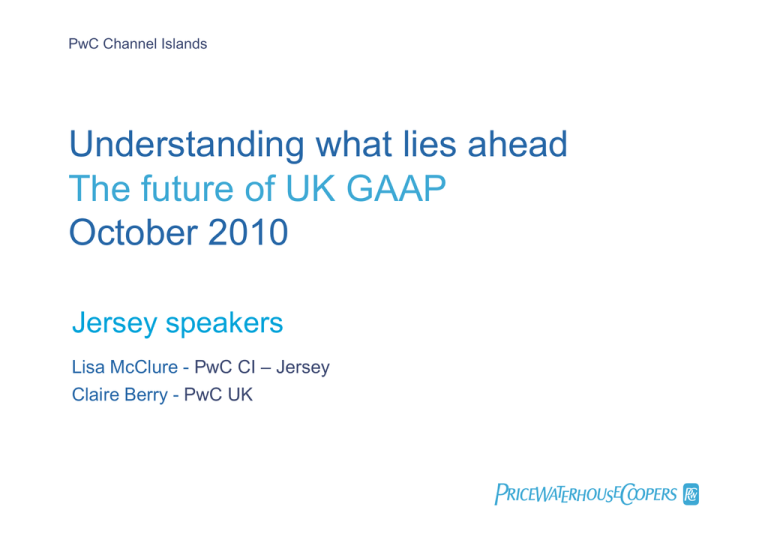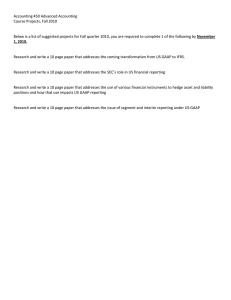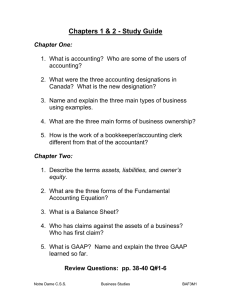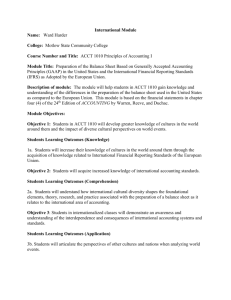
PwC Channel Islands
Understanding what lies ahead
The future of UK GAAP
October 2010
Jersey speakers
Lisa McClure - PwC CI – Jersey
Claire Berry - PwC UK
PwC
Agenda
Current status update
What are the GAAP choices
How we are working with entities
The Future of UK GAAP
PricewaterhouseCoopers
October 2010
Slide 2
Current status update
Summary
IFRS/IFRS for SMEs is a suitable basis to replace UK GAAP
ED expected end of October 2010 – 6 month comment period
Years beginning on or after 1 July 2013 will now be first affected, with early
adoption permitted
The Future of UK GAAP
PricewaterhouseCoopers
October 2010
Slide 3
What are the GAAP choices?
Summary
TIER 1
TIER 2
TIER 3
Listed companies &
Publicly Accountable
entities
All other entities
Small entities*
Eligible to apply
FRSSE
Apply EU-adopted IFRS
Apply UK adopted IFRS
For SME or EU IFRS
Subsidiaries
Subsidiaries
(Tier 1S)
(Tier 2S)
Reduced disclosures
Reduced disclosures
Apply Financial Reporting
Standard for Smaller
Entities (“FRSSE”)
* As defined by the UK Companies Act
The Future of UK GAAP
PricewaterhouseCoopers
October 2010
Slide 4
What are the GAAP choices?
Publicly accountable entities
An entity is considered publicly accountable if:
•
Debt or equity instruments are traded in a public market (or planning
to)
•
It holds assets in a fiduciary capacity for a broad group of outsiders as one of
its primary businesses or is a deposit taking entity
If any “publicly accountable entity” meets all 3 of the UK Companies Act small
company criteria and they are prudentially regulated they will be permitted to use
IFRS for SMEs.
The Future of UK GAAP
PricewaterhouseCoopers
October 2010
Slide 5
What are the GAAP choices?
Industry specific options
Industry
Publicly accountable
GAAP
Trust
Yes
Full IFRS
Open ended funds
Yes
Full IFRS
IMA SORP
Yes/No?
AIC SORP
Banks
Yes
Full IFRS
UK Pension schemes
Yes
Full IFRS
SORP
General Partners/Managers
No
FRSMEs
Closed ended funds /
Partnerships
Other Licensees :
Administrators etc.
The Future of UK GAAP
PricewaterhouseCoopers
Yes/No?
October 2010
Slide 6
What are the GAAP choices?
IFRS for subsidiaries
Disclosure exemptions for subsidiaries whose Parent prepares consolidated
financial statements under full IFRS or equivalent GAAP
•
Consolidation
•
Cash flows
•
Group managed areas where information disclosed in parent financial
statements:
•
Financial instruments (IFRS 7)
•
Employee benefits
•
Share-based payments
•
Certain comparative information (eg PP&E)
•
Related parties (IAS 24) – still under discussion
The Future of UK GAAP
PricewaterhouseCoopers
October 2010
Slide 7
What are the GAAP choices
IFRS for Small and Medium-Sized Entities (“IFRS for SMEs”)
or
FRS for Medium Sized Entities (“FRSME”)
The Future of UK GAAP
PricewaterhouseCoopers
October 2010
Slide 8
What are the GAAP choices?
The SME Standard and its main characteristics
Key characteristics of the IFRS for SMEs standard compared to IFRS
General characteristics
Measurement specialities
Stand–alone Standard – but
based on IFRS principles
Fair value is not the default for
most FI
“Go your own way” (not all IFRICs
/ no annual improvements …..
Removed complex options
… and only bi-annual
maintenance)
Measurement simplifications
Simplified disclosure requirements
Circumstance-driven approach
Plain English
Undue cost or effort
The Future of UK GAAP
PricewaterhouseCoopers
October 2010
Slide 9
What are the GAAP choices?
The SME Standard and its main characteristics
First-time adoption of IFRS for SMEs
•
Full retrospective application of the IFRS for SMEs effective at the reporting
date for an entity's first financial statements prepared in accordance with the
IFRS for SMEs
•
Comparative information is prepared and presented on the basis of the IFRS
for SMEs
•
Adjustments arising from the first-time application of the IFRS for SMEs are
recognised directly in retained earnings (or, if appropriate, another category of
equity) at the date of transition to the IFRS for SMEs
The Future of UK GAAP
PricewaterhouseCoopers
October 2010
Slide 10
What are the GAAP choices?
The SME Standard and its main characteristics
UK amendments to IFRS for SMEs
•
IFRS for SMEs called FRSMEs (FRS for Medium Sized Entities)
•
Definition of publicly accountable – included ‘deposit taking entities’ and
provided more guidance on scope
•
Technical changes:
• IAS 12 replaces tax section
• Removed fair value option for associates and JVs
• Remove certain presentation options
• Period of goodwill amortisation reduced to 5 years
• Retain exemptions: cash flow & consolidation
The Future of UK GAAP
PricewaterhouseCoopers
October 2010
Slide 11
What are the GAAP choices?
What are the key differences?
Area
Statement of
changes in equity
A combined statement of income and retained earnings
Cash flow statement
FRSME maintains cash flow exemption
Financial assets &
liabilities
IFRS for SMEs distinguishes between basic and complex
financial instruments
Investment property
Investment property should be measured at fair value where
this can be done reliably without undue cost or effort
Lease incentives
No guidance
Splitting of
land/buildings
No guidance
Property, plant &
equipment
Classes of PPE are carried at cost less accumulated
depreciation and any impairment losses.
The Future of UK GAAP
PricewaterhouseCoopers
October 2010
Slide 12
What are the GAAP choices?
What are the key differences? (continued)
Area
Borrowing costs
Expensed
Consolidation
“Power to Control”
Associates & Joint
Ventures
Choice cost & equity model
Transaction costs –
Acquisitions
Included in acquisition costs
Intangible assets
All intangible assets are considered to have finite lives and
amortised
Goodwill
Considered finite and amortised over 5 years
The Future of UK GAAP
PricewaterhouseCoopers
October 2010
Slide 13
What are the GAAP choices?
FRSSE - Financial Reporting Standard for Smaller Entities
All financial statements intended to give a true and fair view of the financial position
and profit or loss (or income and expenditure) of all entities that are:
•
Small companies or small groups
•
Entities that would also qualify as small if they had been incorporated, with the
exception of building societies
Small company
Turnover £6,500,000
Balance sheet total £3,260,000
Average number of employees 50
The Future of UK GAAP
PricewaterhouseCoopers
October 2010
Slide 14
What are the GAAP choices?
FRSSE - Financial Reporting Standard for Smaller Entities
What are the benefits of applying FRSSE vs FRS?
FRSSE is the simplified version of FRS. A small company prepares its financial
statements in accordance with FRSSE are exempted from the requirement:
•
To prepare cash flow statement
•
To present a reconciliation of factors affecting the tax charge for the
financial year (FRS16 / FRS19)
•
To show movement in shareholders' funds in the notes to the financial
statements
•
Other statutory disclosure required under UK GAAP
The Future of UK GAAP
PricewaterhouseCoopers
October 2010
Slide 15
How we are working with entities
Initial impact
assessment eg
- Control
- Capital adequacy
- Cost impact
Training /
Embedding
IFRS
Systems review/
Standardising Chart
of accounts
One or a
combination
of:
Understanding
opportunities
and
implications
Considering implication
of transition to IFRS in
current projects/
agreements
What help do you feel you may need?
Current tools and publications
The Future of UK GAAP
PricewaterhouseCoopers
October 2010
Slide 17
Local contact
Lisa McClure
Tel: 01534 838315
Email: lisa.mcclure@je.pwc.com
© 2010 PricewaterhouseCoopers CI LLP. All rights reserved. “PricewaterhouseCoopers” refers to
PricewaterhouseCoopers CI LLP (a limited liability partnership in the United Kingdom) or, as the context requires,
the PricewaterhouseCoopers global network or other member firms of the network, each of which is a separate and
independent legal entity.
PwC





